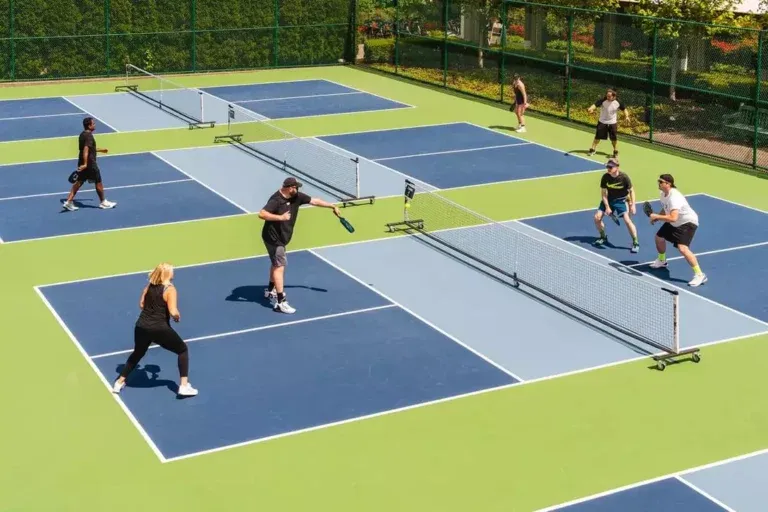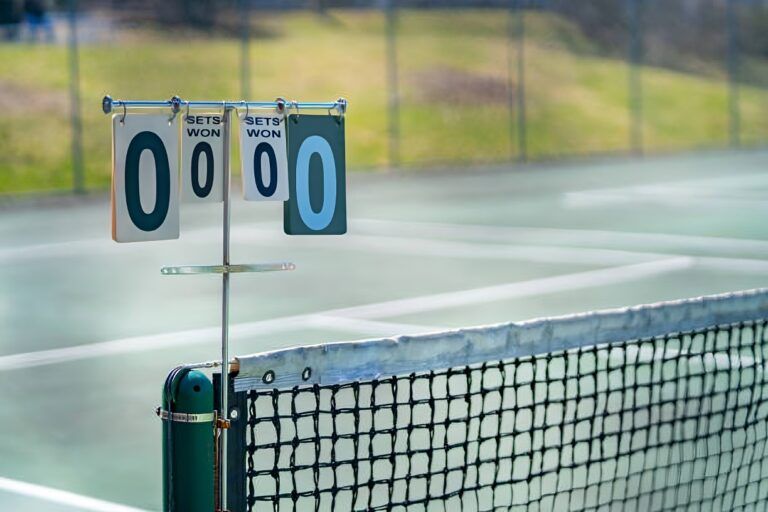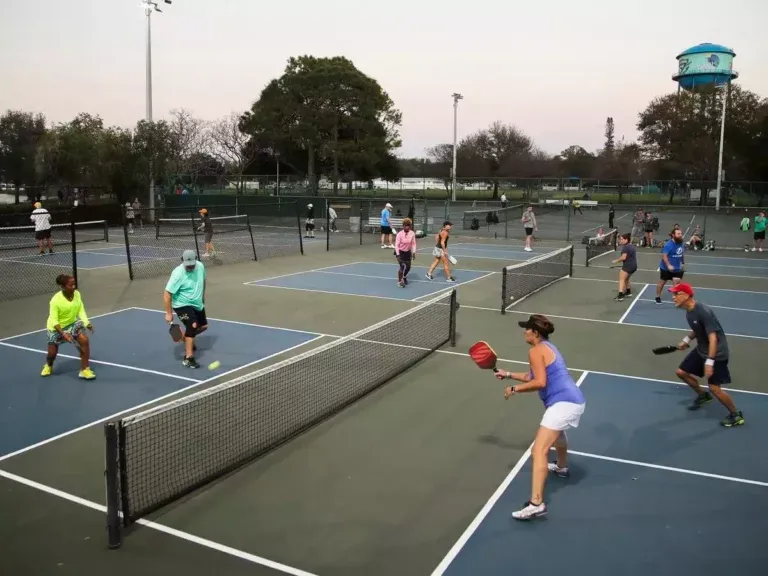Pickleball basics: understanding the game
What is pickleball?
Pickleball is a paddle sport that combines elements from several different games, creating a dynamic and engaging experience for players of all ages and skill levels. The game is played on a court that is about one-third the size of a tennis court, using a special plastic ball and solid paddles made of wood or composite materials. The rules are relatively straightforward, which makes pickleball accessible for beginners while still allowing experienced players to develop intricate strategies.

One of the standout features of pickleball is its inherent social component. As players rally and score points, they often engage in dialogue, share tips, and socialize, making it a fantastic environment for building friendships. It's this blend of friendly competition and community that has fueled its rapid growth and popularity among enthusiasts. Moreover, its adaptability allows it to be played both indoors and outdoors, lending itself well to various environments and weather conditions.
Scoring in pickleball
Understanding the scoring system in pickleball is crucial for both beginners and seasoned players. Generally, the game is played to either 11, 15, or 21 points, and in order to win, a player or team must lead by at least two points. In essence, this system is designed to ensure that matches conclude decisively, favoring the most skillful players.

A unique element of pickleball scoring is the "two clear points" rule, which means that if the game reaches a tie, players must continue to score until one side establishes a two-point lead. This rule introduces an exciting twist to the end of matches, often resulting in tense moments that can last longer than players might anticipate. Understanding these core elements is vital, as they not only dictate the tempo of gameplay but also influence the overall length of each match.
How long does a pickleball game last? Average pickleball game length
Typical casual game duration
For casual players enjoying a friendly pickleball match, the general duration ranges from 15 to 30 minutes. This window captures an array of experiences, from leisurely rounds amongst friends to more spirited contests. In fact, during a typical game populated by beginners, matches might hover around the 15-20 minute mark due to shorter rallies and a higher number of errors.
However, it is critical to emphasize that although these figures represent averages, actual game times can widely vary based on player dynamics. Players focused on enjoyment and learning may take their time, prolonging rallies and allowing the game to extend beyond its usual timeframe. In essence, casual play is flexible, creating a welcoming rhythm where players feel encouraged to enjoy each point as it unfolds, regardless of how long it may last.

Typical tournament match duration
In contrast to casual play, tournament matches introduce a more structured environment that generally increases game lengths. Typically, tournament games last anywhere from 30 to 75 minutes. The format often dictates this duration; for example, single games are shorter than best-of-three matches, where players must win two out of three sets to claim victory.
Interestingly, while casual games might see scores finish early, tournament matches often reach the maximum points, especially under varying formats. Such competitions not only intensify the playing experience but also require players to tap into their skills and endurance. For those considering competitive play, it's essential to be ready for longer matches, as players in these settings may push each other to their limits, resulting in adrenaline-filled exchanges that can stretch well beyond initial expectations.
Factors affecting pickleball game length
Pickleball is a highly dynamic game, and various factors can influence how long matches last. From skill levels to game formats, let's explore the elements that contribute to this variability.
Player skill level
Perhaps one of the most significant determinants of game length is player skill level. Beginners typically experience shorter rallies and higher error rates, resulting in game lengths closer to 15-20 minutes. Conversely, more pro pickleball players can engage in longer rallies, allowing games to extend up to 30 minutes or more.
The interplay between skill and pace introduces a diverse spectrum of gameplay. For instance, in a match between advanced players, each rally could draw out longer, transforming the match into a protracted duel of wit and agility, where every point feels hard-won. This skill-based variance ensures that each match is unique and highlights the breadth of experiences available in the world of pickleball.
Playing style
In pickleball, style plays a critical role in shaping the match's tempo and duration. Players employing defensive strategies tend to engage in longer rallies that can stretch gameplay, while those who favor aggressive playstyles often convert points more rapidly. For example, a strategic dinker may engage opponents in a series of calculated exchanges, slowing down the game with each careful placement.
Thus, understanding one's playing style can greatly affect not just the outcome of the game, but also the time commitment that players should expect. Adapting to various styles can also create a heightened sense of excitement as players learn to navigate different strategies employed by their opponents.
Scoring format
The scoring format in pickleball also significantly impacts game duration. Standard matches are often played to 11 points, but variations exist, including games played to 15 or even 21 points. Longer games tend to draw out additional moments of tension as players contend with the pressure of needing to score the extra points required for victory.
For casual players, flexibility in scoring can be advantageous; they can adjust point totals to suit their preferences. In tournament contexts, however, scores may be more rigidly defined, leading to a more predictable length across matches. This structured approach ensures that player readiness is paramount, encouraging athletes to maintain their stamina for unexpected lengths of play.
Faults and errors
An element often overlooked in determining game duration is the frequency of faults and errors. While they represent moments of frustration, they may also serve as a key factor in shortening rallies and, in turn, matches. Beginner players, who are likely to experience a higher rate of service errors and unforced mistakes, often find themselves completing games in shorter windows.
As players refine their skills, they can engage in fewer errors, potentially elongating the time they spend on the court. This learning curve becomes an exciting journey, where each game not only serves as a competition but also as an opportunity for growth and improvement in their gameplay.
Serve possession
Winning service points holds a fundamental place in pickleball strategy, impacting a game's flow and length. Effective serves often swing the momentum in favor of one team, leading to increased scoring opportunities. Players adept at maintaining a winning service streak can accelerate match time, as points are scored more quickly.
Conversely, frequent changes in serve a common occurrence in matches can extend gameplay as players need to adjust and strategize anew in their roles. The ballet of serve and return emphasizes the dynamic nature of gameplay, where each decision can elongate or shorten the match duration, contributing to the unpredictable thrill of pickleball.
Weather conditions (for outdoor play)
For players who partake in outdoor pickleball, environmental factors come into play as significant variables. Weather conditions, such as wind, heat, or sudden downpours, can dramatically alter gameplay pace and stamina. For instance, strong winds might disrupt the trajectory of serves and returns, forcing players to recalibrate their strikes while lengthening rally durations.
Stamina, too, is impacted by temperature; high heat can lead to fatigue and hinder quick movements, ultimately extending match periods. Players who take note of their surrounding conditions can strategically modify their approach, embracing or countering these environmental elements to sustain their performance throughout a match.
Pickleball tournament formats and durations
Types of pickleball tournaments
As pickleball's popularity continues to soar, various tournament formats have emerged, each with its unique structure and playstyle implications. Understanding these formats can help players prepare mentally and physically for the intensity of competition.
Commonly embraced formats include:
- Single Elimination: The most straightforward format, where teams or players are eliminated after a single loss. This format can lead to quicker tournament durations.
- Double Elimination: A slightly more forgiving structure, where players or teams have a second chance to compete, extending the tournament length as matches progress.
- Round Robin: Each player or team competes against all others within their group. This format increases the number of matches and maximizes playtime, making it suitable for local tournaments.
Visual representation of these tournament types can be beneficial for newcomers, illustrating how players navigate through their matches and progress towards potential victory.
Estimating tournament time commitment
To estimate time commitments for participation in tournaments, several factors must be considered. These include the number of participants, the chosen format, and the average length of matches. For local tournaments held within a community, durations might average 2-4 hours, encompassing several rounds of play. In contrast, larger tournaments can span an entire weekend, with participants engaging in extended bouts across multiple days.
Understanding these time commitments is crucial for players making decisions about participation, particularly for those balancing personal schedules. Each tournament setting offers a unique blend of competition, engagement, and commitment, appealing to a wide range of pickleball enthusiasts.
Pickleball vs. other racket sports: a time comparison
Comparing average game lengths
When comparing pickleball to its racket sport counterparts such as tennis, badminton, and squash, one can observe notable distinctions in average game lengths. Presenting these comparisons in a table format aids in highlighting the typically shorter duration of pickleball games:
| Sport | Average Game Length |
|---|---|
| Pickleball | 15-30 minutes |
| Tennis | 30-90 minutes |
| Badminton | 20-60 minutes |
| Squash | 20-40 minutes |
| Table Tennis | 10-30 minutes |
As illustrated, pickleball occupies a unique position among these sports, often offering quicker matches that can appeal to players seeking both efficiency and excitement. This trend contributes to greater accessibility, allowing players to join multiple games within a shorter timeframe and enjoy more time on the court overall.
The "two clear points" rule: how it can make games longer
Explaining the rule
As discussed earlier, the "two clear points" rule holds a pivotal role in pickleball's scoring system. When players reach a 10-10 tie, they must continue competing until one side establishes a two-point lead. This unique stipulation introduces an intense atmosphere in matches, often leading to lengthy exchanges as each team strives to secure that crucial edge.
The psychological aspect of this rule cannot be overstated; the tension of closely contested games draws audiences into a whirlwind of expectations. Players must remain mentally sharp, knowing that a single error could swing the match's outcome. This pressure fuels competitive spirit and often postpones the inevitable conclusion, occasionally resulting in an extended match advertised for its gripping finale.
Examples of close games
Close games often yield memorable moments within pickleball, where the excitement can reach fever pitch. For instance, consider a hypothetical match where both teams reach a tied score of 10-10. Players find themselves locked in a series of exhilarating rallies, showcasing their skills while battling for supremacy. As the scores inch ahead to 12-12, and then 13-13, adrenaline builds, and spectators on the sidelines become engrossed in the unfolding drama.
Such scenarios illustrate how the "two clear points" rule can push matches to lengths far beyond typical expectations. These heightened exchanges not only entertain players and audiences alike, but they also cement enduring memories within the sport, demonstrating why the rule remains an integral component of the game's allure.
Fun pickleball facts: longest game, longest rally, and more
Record-breaking pickleball
In a sport rich with stories and records, remarkable accomplishments stand out, capturing the imaginations of both enthusiasts and onlookers alike. The record for the longest pickleball game is an astonishing 24 hours, showcasing the endurance and passion of the players involved. This match stands as a testament to the spirit of competition and camaraderie that defines pickleball.
In addition to prolonged matches, pickleball also boasts fascinating records concerning rally lengths. The Guinness World Record for the longest rally a staggering 16,046 shots highlights the incredible skill and stamina that can be found within the sport. Such record-breaking feats emphasize the unique nature of pickleball and the challenges that accompany its gameplay.
Unusual scoring scenarios
While capturing the spirit of competition, pickleball's unique scoring rules can lead to unusual situations within matches. For instance, certain point discrepancies due to unanticipated faults can create moments of surprising outcomes, where the expected conclusion of a match takes unexpected turns. Occurrences such as an unanticipated sudden-death scenario can keep players and spectators on their toes, adding an additional layer of excitement and unpredictability to the sport.
These unique quirks contribute to the charm of pickleball and offer players and fans alike an opportunity to share remarkable anecdotes and experiences that only this dynamic sport can provide.
Tips for newbies: managing your pickleball time
Choosing the right game format
For newcomers to pickleball, understanding the various game formats is essential for managing time effectively and maximizing enjoyment. Casual play offers flexibility, allowing players to tailor match types that suit their schedules while fostering a relaxed atmosphere.
For those interested in tournament participation, it is advisable to select formats that complement available time commitments and personal aspirations in competition. Ultimately, finding the right balance between competitive spirit and enjoyable play can lead to a fulfilling experience for beginner players seeking their place in the world of pickleball.
Setting realistic expectations
Additionally, setting realistic expectations regarding game lengths can help manage newcomers' experiences. Understanding that games often vary in duration and are influenced by a variety of factors such as player skill, style, and strategy helps to minimize any potential disappointment.
By embracing these variables, newbie players can cultivate a mindset that prioritizes learning and enjoyment. This perspective encourages a gradual climb on the learning curve, ensuring that every match serves as both an enjoyable experience and an opportunity for improvement.
Conclusion
In summary, the duration of a pickleball game can be highly variable and influenced by several factors, including player skill levels, game formats, and the competitive nature of the match. The typical casual game lasts between 15 to 30 minutes, while tournament matches can extend up to 45 minutes or longer. Understanding these dynamics allows players to better plan their time and expectations, as they embrace the enjoyable and engaging spirit of pickleball. New players are encouraged to immerse themselves in the flexibility of this dynamic sport, fostering a sense of community and camaraderie while they enjoy the enriching experience that pickleball has to offer.










